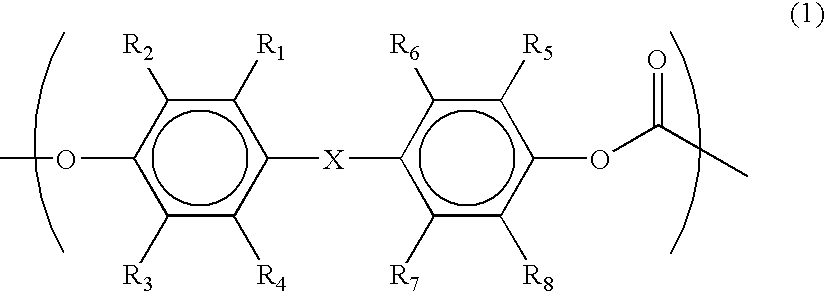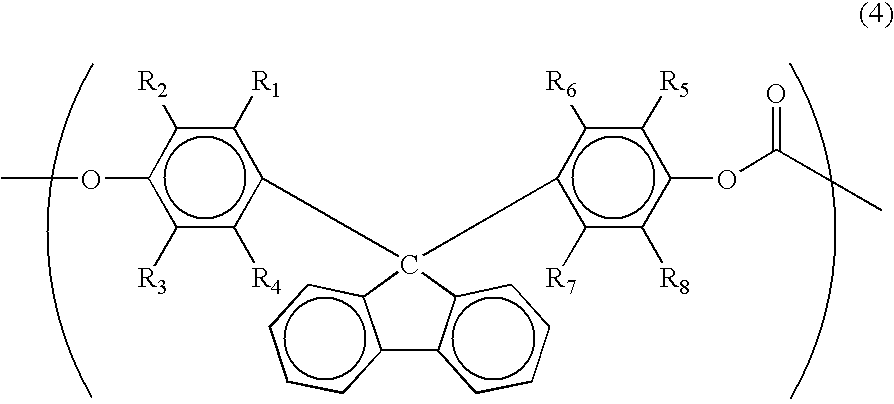Laminate for dye-sensitized solar cell, electrode for dye-sensitized solar cell and method for producing it
a solar cell and dye-sensitized technology, applied in the direction of electrochemical generators, sustainable manufacturing/processing, final product manufacturing, etc., can solve the problems of limited installation conditions of solar cells containing glass supports, inability to sintered porous semiconductor layers at a sufficiently high temperature, and heavy glass. , to achieve the effect of high photovoltaic power generation efficiency, high durability and flexibl
- Summary
- Abstract
- Description
- Claims
- Application Information
AI Technical Summary
Benefits of technology
Problems solved by technology
Method used
Image
Examples
example 1
Formation of Polymer for Film
[0100]100 parts of dimethyl naphthalene-2,6-dicarboxylate and 60 parts of ethylene glycol were interesterified for 120 minutes with 0.03 parts of manganese acetate tetrahydrate serving as an interesterification catalyst, with gradually elevating its temperature from 150° C. to 238° C. When the reaction temperature reached 170° C. in the course of the reaction, 0.024 parts of antimony trioxide was added to it, and after the transesterification reaction, trimethyl phosphate (the ester solution subjected to heat treatment in ethylene glycol at 135° C. under a pressure of from 0.11 to 0.16 MPa for 5 hours, and its trimethyl phosphate content is 0.023 parts) was added to it. Next, the reaction product was transferred into a polymerization reactor, heated up to 290° C., and subjected to polycondensation at a high vacuum of at most 27 Pa, thereby obtaining polyethylene-2,6-naphthalenedicarboxylate having an intrinsic viscosity of 0.63 dl / g and not substantially...
example 2
[0114]A hard coat layer-having polyester film was produced in the same manner as in Example 1, for which, however, the stretching condition of the polyester film was changed as in Table 1. On the hard coat layer, formed was a transparent conductive layer of IZO having a thickness of 130 nm, according to a direct-current magnetron sputtering process using an IZO target that comprises essentially indium oxide and contains 7.5% by weight of zinc oxide added, thereto. The formation of the transparent conductive layer through sputtering was as follows: Before plasma discharge, the inside of the chamber was degassed to a degree of 5×10−4 Pa, then argon and oxygen were introduced into the chamber and the pressure was increased up to 0.3 Pa. A power was applied to the IZO target at a current density of 2 W / cm2. The oxygen partial pressure was 3.7 mPa. The surface resistivity of the transparent conductive layer was 28 Ω / square. Next, using a normal-pressure plasma surface treatment device (S...
example 4
Formation of Polycarbonate Film
[0117]284 parts by weight of 3,3′,5,5′-tetramethylbisphenol A and 225 parts by weight of DPC were polymerized through de-phenolation, using 0.2 parts by weight of sodium salt of bisphenol A as a catalyst, in a nitrogen atmosphere at 200 to 280° C., thereby obtaining a homopolymer of 3,3′,5,5′-tetramethylbisphenol A. The limiting viscosity number of the polymer was 0.35. The polymer was dissolved in methylene chloride to prepare a 22 wt. % solution. The obtained solution was cast onto a polyester film according to a die coating process, and then dried at 100° C. for 10 minutes to thereby form a polycarbonate film having a thickness of 120 μm.
[0118]After treated at 200° C. for 10 minutes, the thermal shrinkage of the polycarbonate film in the machine direction thereof was −0.98%; and the thermal shrinkage thereof in the transverse direction was −0.97%. After treated at 230° C. for 10 minutes, the thermal shrinkage of the film in the machine direction was...
PUM
 Login to View More
Login to View More Abstract
Description
Claims
Application Information
 Login to View More
Login to View More - R&D
- Intellectual Property
- Life Sciences
- Materials
- Tech Scout
- Unparalleled Data Quality
- Higher Quality Content
- 60% Fewer Hallucinations
Browse by: Latest US Patents, China's latest patents, Technical Efficacy Thesaurus, Application Domain, Technology Topic, Popular Technical Reports.
© 2025 PatSnap. All rights reserved.Legal|Privacy policy|Modern Slavery Act Transparency Statement|Sitemap|About US| Contact US: help@patsnap.com



